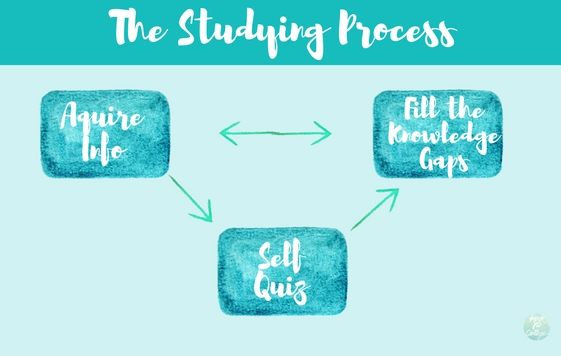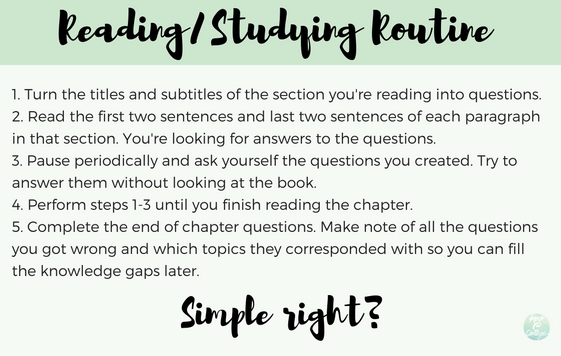In my last video, why your current study routine isn’t working, I explained how study routines serve as a clear set of steps that when followed consistently, inevitably help you achieve all of your academic goals.
To help you begin creating your consistent study routine, I gave you a list of 43 different learning activities that are proven to best help you learn and test your knowledge.
All the learning activities I gave you work, but the best study routines contain only those activities that will be the most effective for your current classes.
In the book the science of successful learning, the authors say that one of the best routines a learner can instill in herself is self-quizzing. This allows her to learn and understand what it is that she knows, and what it is that she still does not know, about the information she is going to be tested on.
This quote is the reason why in part two of the study routine series, I told you that one of the most important questions to ask yourself when you’re creating your study routine is: What learning activities will help me best learn and test my knowledge on the material for the class?
I say it all the time, the whole point of studying is to figure out what you don’t know so that you can do something about it.
These are the steps of the studying process. A well-built study routine will hit every single step.
- Aquiring the information you need to know. This part is easy because all it takes is getting the information into your brain. You do that in lecture and when you’re reading the chapter.
- Self-quizzing or self-assessing. This is where you put into place the act of trying to figure out what you fully understood, and what about the information you just acquired, you still don’t know. You do this by asking yourself questions, doing your homework without your notes, and doing practice quizzes and exams without your textbook.
- Filling in the knowledge gaps. The reason we do step 2 is to figure out what we don’t know so that we can relearn it. The way we relearn or fill in our knowledge gaps is by seeking out additional help. This can be done by attending lecture, getting one-on-one help from your professor, tutoring, supplemental videos online, study groups or even the study guide that comes with our textbooks.

To help you better understand how a study routine covers each and every single one of the steps that need to be a part of the studying process, I am going to give you a sample study routine I would use to study for a Biology class.
After my first class of the day, I normally walk past the library. Walking past the library is my cue to begin my routine. So I turn into the library to begin reading for my Biology class tomorrow.
We’re going to be covering chapter two, so I open to that chapter and begin reading.
HERE ARE THE STEPS OF MY STUDY ROUTINE FOR THIS CLASS:
Step One: As I read, I turn the title and subtitles of the section I am reading into questions.
Example Titles and subtitles: The Eukaryotic Cell. Characteristics of Eucaryotic cells. Eukaryotic Cell Structure.
Example Questions I Can Make: What are Eukaryotic cells? How are Eukaryotic cells different from Prokaryotic cells? What are the defining characteristics of Eukaryotic cells? What are the internal structures of Eukaryotic cells?
Step Two: I read the first two sentences and last two sentences of each paragraph in that eukaryotic cell section. What I am doing is looking to see if they answer the questions I created. This helps narrow my focus when I’m reading.
Step Three: When I am done reading that section, I pause and ask myself the questions I created. I try to answer it without looking at the book.
Step Four: I perform Step 1-3 until I finish reading the chapter.
Step Five: I perform the end of chapter questions to test my knowledge on the chapter I just read. I make note of all the questions I got wrong and which topics they corresponded to so I can fill the knowledge gaps later.

Already by just reading the chapter, I completed Step 1 and Step 2 of the learning process.
As I was reading, I was acquiring new information about Eukaryotic cells. When I asked myself the questions and tried to answer them, that was a method of self-quizzing. Completing the end of chapter questions was another method of self-quizzing.
These self-quizzing sessions help me figure out what I still don’t know. Tomorrow in lecture, I can have those knowledge gaps filled.
HOW TO FILL THE KNOWLEDGE GAPS
I make sure to pay special attention to the topics when the professor covers them in lecture. I also make an effort to ask the appropriate questions so that this time, I get it. I want to leave that lecture having filled in as much of my knowledge gaps as possible to ensure I know everything I need to know to pass the exam.
By performing this routine, in just a couple of days, I have already performed all of the steps of the studying process.
Not only does this method help me cover all of my bases of knowing everything I need to know for the exam, but now I also have a set of steps that I can review, reassess and alter if I get my exam back and I did not get the grade I wanted.
If I failed the exam, obviously something in my study routine wasn’t working and now I have something I can bring to the professor. They can help me review my current process and figure out the learning activities that would be better suited for their style of teaching and type of exams.
When you create a study routine, you don’t just want to put it in place without regularly assessing whether or not it’s actually working for you.
